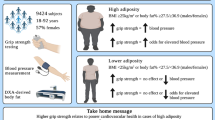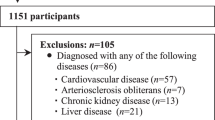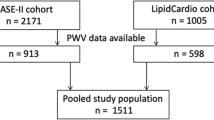Abstract
Studies have reported conflicting results on the association between handgrip strength (HGS) and blood pressure during childhood and adolescence. High multicollinearity involving somatic components that influence both HGS and blood pressure might be an important source of bias. This study sought to investigate the independent effects of HGS and muscle mass on blood pressure levels in children and adolescents. Muscle mass and fat mass (Multifrequency Electrical Bioimpedance) and systolic (SBP) and diastolic (DBP) blood pressure (Automatic oscillometric device) were assessed in 833 volunteers aged 6–18 years, of both sexes. Handgrip strength-for-age quartiles were calculated and participants were assigned to groups by HGS quartiles. Analysis of covariance was conducted to address the linear association between HGS and SBP adjusted for height, muscle mass, and fat mass. To test for linear trend, contrast analysis was conducted. Partial eta-squared was used to confirm or rule out a small significant effect of the independent variables on SBP. The effect size of HGS on SBP was not significant in both sexes. In girls, 1.7% of the between-groups variance in SBP was accounted for by muscle mass (P = 0.016). In boys, 2.3% and 1.8% of the between-groups variance in SBP was accounted for by muscle mass (P = 0.001) and height (P = 0.005), respectively. In conclusion, children with a more advanced physical maturity for their age, that is, who are taller, stronger, and have greater fat-free mass, may be nearly reaching the physiological parameters of adulthood, and consequently have higher systolic blood pressure.
This is a preview of subscription content, access via your institution
Access options
Subscribe to this journal
Receive 12 digital issues and online access to articles
$119.00 per year
only $9.92 per issue
Buy this article
- Purchase on Springer Link
- Instant access to full article PDF
Prices may be subject to local taxes which are calculated during checkout


Similar content being viewed by others
Data availability
Current data and code can be requested by email from the corresponding author.
References
World Health Organization. Making a difference: indicators to improve children’s environmental health/prepared by David Briggs. World Health Organization, 2003. https://apps.who.int/iris/handle/10665/43721.
Neira M, Fletcher E, Brune-Drisse MN, Pfeiffer M, Adair-Rohani H, Dora C. Environmental health policies for women’s, children’s and adolescents’ health. Bull World Health Organ. 2017;95:604–6. https://www.who.int/bulletin/volumes/95/8/16-171736/en/.
Neu CM, Rauch F, Rittweger J, Manz F, Schoenau E. Influence of puberty on muscle development at the forearm. Am J Physiol Endocrinol Metab. 2002;283:E103–7.
Dai S, Fulton JE, Harrist RB, Grunbaum JA, Steffen LM, Labarthe DR. Blood lipids in children: age-related patterns and association with body-fat indices. Am J Prev Med. 2009;37:S56–64.
Gerber LM, Stern PM. Relationship of body size and body mass to blood pressure: sex-specific and developmental influences. Hum Biol. 1999;71:505–28.
Daniels SR, Kimball TR, Khoury P, Witt S, Morrison JA. Correlates of the hemodynamic determinants of blood pressure. Hypertension. 1996;28:37–41.
Genovesi S, Antolini L, Giussani M, Brambilla P, Barbieri V, Galbiati S, et al. Hypertension, prehypertension, and transient elevated blood pressure in children: association with weight excess and waist circumference. Am J Hypertens. 2010;23:756–61.
Weres A, Baran J, Czenczek-Lewandowska E, Leszczak J, Mazur A. The association between steps per day and blood pressure in children. Sci Rep. 2022;12:1422.
Leong DP, Teo KK, Rangarajan S, Lopez-Jaramillo P, Avezum A Jr, Orlandini A, et al. Prospective Urban Rural Epidemiology (PURE) Study investigators. Prognostic value of grip strength: findings from the Prospective Urban Rural Epidemiology (PURE) study. Lancet. 2015;386:266–73.
Ortega FB, Silventoinen K, Tynelius P, Rasmussen F. Muscular strength in male adolescents and premature death: cohort study of one million participants. BMJ. 2012;345:e7279.
Ruiz JR, Ortega FB, Rizzo NS, Villa I, Hurtig-Wennlöf A, Oja L, et al. High cardiovascular fitness is associated with low metabolic risk score in children: the European Youth Heart Study. Pediatr Res. 2007;61:350–5.
Ortega FB, Ruiz JR, Castillo MJ, Sjöström M. Physical fitness in childhood and adolescence: a powerful marker of health. Int J Obes. 2008;32:1–11.
Peterson MD, Saltarelli WA, Visich PS, Gordon PM. Strength capacity and cardiometabolic risk clustering in adolescents. Pediatrics. 2014;133:e896–903.
Artero EG, Ruiz JR, Ortega FB, España-Romero V, Vicente-Rodríguez G, Molnar D, et al. Muscular and cardiorespiratory fitness are independently associated with metabolic risk in adolescents: the HELENA study. Pediatr Diabetes. 2011;12:704–12.
Dong B, Wang Z, Arnold L, Song Y, Wang HJ, Ma J. The association between blood pressure and grip strength in adolescents: does body mass index matter? Hypertens Res. 2016;39:919–25.
Zhang R, Li C, Liu T, Zheng L, Li S. Handgrip strength and blood pressure in children and adolescents: evidence from NHANES 2011 to 2014. Am J Hypertens. 2018;31:792–6.
Shrestha N. Detecting multicollinearity in regression analysis. Am J Appl Math. 2020;8:39–42.
Rantanen T, Guralnik JM, Foley D, Masaki K, Leveille S, Curb JD, et al. Midlife hand grip strength as a predictor of old age disability. JAMA. 1999;281:558–60.
Giampaoli S, Ferrucci L, Cecchi F, Lo Noce C, Poce A, Dima F, et al. Hand-grip strength predicts incident disability in non-disabled older men. Age Ageing. 1999;28:283–8.
Metter EJ, Talbot LA, Schrager M, Conwit R. Skeletal muscle strength as a predictor of all-cause mortality in healthy men. J Gerontol A Biol Sci Med Sci. 2002;57:B359–65.
Chan DCC, Lee WTK, Lo DHS, Leung JCS, Kwok AWL, Leung PC. Relationship between grip strength and boné mineral density in healthy Hong Kong adolescents. Osteoporos Int. 2008;19:1485–95.
Rioux BV, Kuwornu P, Sharma A, Tremblay MS, McGavock JM, Senechal M. Association between handgrip muscle strength and cardiometabolic z-score in children 6 to 19 years of age: results from the Canadian health measures survey. Metab Syndr Relat Disord. 2017;15:379–84.
Fredriksen PM, Mamen A, Hjelle OP, Lindberg M. Handgrip strength in 6-12-year-old children: the Health Oriented Pedagogical Project (HOPP). Scand J Public Health. 2018;46:54–60.
Booth A, Johnson DR, Granger DA, Crouter AC, McHale S. Testosterone and child and adolescent adjustment: the moderating role of parent-child relationships. Dev Psychol. 2003;39:85–98.
Eissa MA, Mihalopoulos NL, Holubkov R, Dai S, Labarthe DR. Changes in fasting lipids during puberty. J Pediatr. 2016;170:199–205.
Zaniqueli D, Alvim RO, Baldo MP, Morra EA, Mill JG. Muscle mass is the main somatic growth indicator associated with increasing blood pressure with age in children and adolescents. J Clin Hypertens. 2020;22:1908–14.
Ploegmakers JJ, Hepping AM, Geertzen JH, Bulstra SK, Stevens M. Grip strength is strongly associated with height, weight and gender in childhood: a cross sectional study of 2241 children and adolescents providing reference values. J Physiother. 2013;59:255–61.
Demmer DL, Beilin LJ, Hands B, Burrows S, Cox KL, Straker LM, et al. Effects of muscle strength and endurance on blood pressure and related cardiometabolic risk factors from childhood to adolescence. J Hypertens. 2016;34:2365–75.
Garcia-Hermoso A, Vegas-Heredia ED, Fernández-Vergara O, Ceballos-Ceballos R, Andrade-Schnettler R, Arellano-Ruiz P, et al. Independent and combined effects of handgrip strength and adherence to a Mediterranean diet on blood pressure in Chilean children. Nutrition. 2019;60:170–4.
Agostinis-Sobrinho C, Ruiz JR, Moreira C, Lopes L, Ramírez-Vélez R, García-Hermoso A, et al. Changes in muscular fitness and its association with blood pressure in adolescents. Eur J Pediatr. 2018;177:1101–9.
Díez-Fernández A, Sánchez-López M, Gulías-González R, Notario-Pacheco B, Cañete García-Prieto J, Arias-Palencia N, et al. BMI as a mediator of the relationship between muscular fitness and cardiometabolic risk in children: a mediation analysis. PLoS One. 2015;10:e0116506.
Larsen MN, Krustrup P, Araújo Póvoas SC, Castagna C. Accuracy and reliability of the InBody 270 multi-frequency body composition analyser in 10-12-year-old children. PLoS One. 2021;16:e0247362.
Acknowledgements
The authors wish to thank the unwavering support of “Estação Conhecimento” and VALE Foundation, Vitória, Espírito Santo, Brazil, during the period of data collection. This work was supported by the Pro-Rectory of Research and Post-Graduate Studies of the Federal University of Amazonas (Institutional Program of Scientific Initiation Scholarships 2021/22); Foundation for Supporting Research and Innovation of Espírito Santo (FAPES)-Research Program for SUS (PPSUS) (grant 65854420/2014); Fundação VALE; Higher Education Personnel Improvement Coordination (Coordenação de Aperfeiçoamento de Pessoal de Nível Superior, Capes); and Laboratory Thommasi of Vitória, Espírito Santo, Brazil, who funded part of the biochemical exams. Scientific Initiation scholarship awarded by Foundation Support of Research the State of Amazonas (FAPEAM) to author Paula Adriana dos Santos de Fontes. The funders had no role in the: design and conduct of the study; collection, management, analysis, and interpretation of the data; preparation, review, or approval of the manuscript; and decision to submit the manuscript for publication.
Funding
All phases of this study were supported by FAPES/PPSUS (No. 65854420/2014) and Fundação Vale.
Author information
Authors and Affiliations
Contributions
PASF, DZ, and JHS analyzed the data, interpreted the results, and drafted the manuscript. ROA, JGM, and EAM participated in the design of the work and contributed to the analysis of data and interpretation of results. PRO and LCAPM contributed to acquisition of data. JGM and DZ participated in the design of the work and supervised the acquisition of data. ROA conceptualized and designed the study, and critically reviewed the manuscript for important intellectual content. All authors approved the final manuscript as submitted and agree to be accountable for all aspects of the work.
Corresponding author
Ethics declarations
Competing interests
The authors declare no competing interests.
Additional information
Publisher’s note Springer Nature remains neutral with regard to jurisdictional claims in published maps and institutional affiliations.
Rights and permissions
Springer Nature or its licensor (e.g. a society or other partner) holds exclusive rights to this article under a publishing agreement with the author(s) or other rightsholder(s); author self-archiving of the accepted manuscript version of this article is solely governed by the terms of such publishing agreement and applicable law.
About this article
Cite this article
dos Santos de Fontes, P.A., Zaniqueli, D., Siqueira, J.H. et al. Role of muscle mass in the association between handgrip strength and blood pressure in children and adolescents. J Hum Hypertens 38, 128–133 (2024). https://doi.org/10.1038/s41371-023-00863-5
Received:
Accepted:
Published:
Issue Date:
DOI: https://doi.org/10.1038/s41371-023-00863-5



